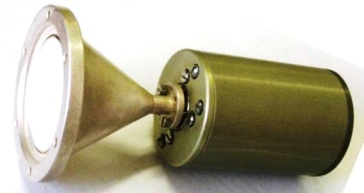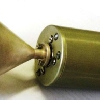What is Microwave Vibration Sensor?
 The vibrations and oscillations are so natural phenomenon in the technics, as sea surf or wind in the nature. However, in contrast to the natural oscillation, vibration in the machinery in most cases regarded as a harmful factor that accelerates the destruction of equipment, engineering infrastructure and even buildings. The vibrations and oscillations are so natural phenomenon in the technics, as sea surf or wind in the nature. However, in contrast to the natural oscillation, vibration in the machinery in most cases regarded as a harmful factor that accelerates the destruction of equipment, engineering infrastructure and even buildings.
The exception is a fairly small class of mechanisms, where the vibration is used to achieve the effect of operating or movement – vibration compactors for concrete, equipment for mixing of liquids by shaking them, etc. But, in all other cases, it is required to reliably keep the vibration under control and/or precisely measure its value to comply these parameters do not exceed the specs of the mechanism. |
Microwave sensor vs sensor based on other technology
Microwave vibration sensor RVS-94 (94 GHz radar vibration sensor) is designed for non-contact vibration control of mechanisms and buildings. It is intended to measure vibro parameters at the conditions where it is difficult or impossible to do by traditional contact vibration sensors (so-called transducers), ultrasound or laser vibration sensors.
Microwave vibration sensor may be also proffered if measurements by other type of sensor are just uneconomical. Just like any other non-contact measurement methods like ultrasound or laser ones, the microwave method has the important feature of inertia-free measurement, which allows obtaining the most accurate vibration data.
RVS-94 measures the parameter that called “Vibro velocity” in the technical literature (aka vibration frequency). This is one of the most important parameters of the periodic movement of the controlled object. Another important parameter is the vibration amplitude, which can be also measured using microwave sensor working as wireless rangefinder.
RVS-94 sensor could be used in cases where it is impossible to establish a contact sensor on an object performing mechanical oscillations due to the complexity of fastening or disrupt of object rotation balance. Also, microwave measuring method implemented in the RVS-94, has advantages over other methods of non-contact, if the object is located at an excessive distance from the transducer or there is optical obstacles like dust, steam, smoke, etc. These are conditions where ultrasonic sensors (if distance more than 2 m) or laser sensors (if presence of optical interference) cannot operate at all.
Where to use microwave sensor
The most demanding applications for microwave vibration sensors RVS-94 are oil and gas industry, power generation, marine engine building, machine tools, turbine construction (steam and gas turbines), automotive and aircraft engine design etc. Service and repair enterprises engaged in the maintenance of aircraft and marine engines, compressor systems, large diesel and gas turbine power generators also in need of vibration sensors. The list of wireless vibration sensor applications include gas pipelines, oil and coal pipelines, raw material pumping, gas pumping units and other large machinery at oil processing systems.
Control of vibration is also required in semiconductor electronics as control of vibration for growing crystals equipment, photolithography systems, etc.
Despite contact sensors are widely used for the control of vibration because of its cheapness, they have a number of disadvantages such as the possible loss of contact with the object in their long-term use or when use in aggressive environments. This is especially true in the oil and gas industry, where compressor stations are often located at a considerable long distance from the control center, and year-round work in conditions of low/high temperature and high humidity of the ambient air. Failure of a contact from sensor to the object or unplugging of sensor cable — these all lead to a false signal of oil&gas compressor equipment malfunction. As a result, service team could be send to compressor site by mistake and this is waste of time of personnel.
94 GHz microwave sensor advantages
What are the advantages of microwave vibration sensors RVD-94 over other types of vibration sensors that are on the market – even including radio (radar) sensors from other manufacturers?
• Vs contact sensor. The most important advantage of the radar vibration sensor compare to contact sensors is the ability to replace, reinstall or reconfigure it at a new position without disassembly or interruption of movement of the controlled object. The contact sensors need to get the mechanism stopped and then replace the failed sensor. Therefore, the advantage of the low cost of contact sensors are often become false consider the cost of sensor installation, replacement, and reassembly.
• Vs laser sensor. The advantage of microwave vibration sensor compare to laser sensors is the ability to conduct successful vibration measurements even if the beam path goes through smoke, heavy dust or water vapor – i.e. conditions that do not allowing operate laser sensors.
• Vs ultrasonic sensor. Microwave vibration sensor also wins against ultrasonic vibration sensors due to the possibility of vibration measurements, occurring at high frequencies, where such sensors can not be used, as well as on distances, inaccessible to ultrasound measurements (more than 2 m).
• Vs obsolete type of microwave sensor. RVS-94 microwave sensor is also better than same sensors operating in frequency band of more common 3 GHz to 30 GHz. Due to the laws of physics, the accuracy of the measurement of frequency and amplitude of vibration via the RVS-94 operating in the millimeter wave range – higher than that of microwave sensors of other manufacturers using for sensors traditional radio bands (3-30 GHz).
And one more thing, this time — the unique property of vibration sensors RVS-94 that is inaccessible to vibration sensors working on other physical principles. RVS-94 could measure the amplitude and frequency of vibration of objects located within the housing or casing, provided that it is radio transparent sheath (plastic, cardboard, glass, wood). For example, RVS-94 can measure parameters in the vibration of the pendulum placed in a glass.
More about RVS-94 sensor
Vibration sensor RVS-94 is intended to measure the linear velocity of the object along the measurement axis. The sensor probe signal is generated at a fixed frequency.
It is possible to run frequency and amplitude vibration measurements on one coordinate (1D), on two as 2D or on three dimensions (3D). For this purpose use, respectively, 1, 2 or 3 R RVS-94 vibration sensors directed on to object. An example of the object performing 3D-dimensional vibration is the turbine shaft. During rotation it is generally subjected to vibrations which occur both side and runout vibration in the form of so called “air eights” and other 3D shapes.
A special feature of RVS-94 microwave vibration sensor is a high frequency of the probe beam, which is equal to 94 GHz. As a result, 94 GHz is a quasi-optical – like laser beam – propagation of the probing radiation. This allows exploring of vibrations of structures and mechanisms in the selected control points with very higher quality. For exact positioning of the spot on the object it’s possible to use shading screens and diaphragms.
Given that the wavelength of the 94 GHz radiation is 3 mm, this vibration sensor provides exceptional accuracy and frequency of measurement of vibration amplitude. Features of 94 GHz range, wherein the sensor operates, allow use miniature antennas compare to big ones for more common on market 3-30 GHZ sensor frequency. In some cases, when an object is placed in a special room or a shell – it is critically important allowing placing the antenna in front of the small-sized access windows. In other words, it is possible to conduct remote measurements of vibration of the object through such small hole or window, where it is impossible to use conventional 3 to 30 GHz microwave sensors.
Vibration measurement range starts with 0 Hz, thus RVS-94 vibration sensor RSD-94 can be used as a contactless micrometer, providing information about object’s elastic deformations under the influence of the static forces or measured low frequency vibrations with high precision.
RVS-94 output interface
RVS-94 vibration sensor can be equipped with a wide number of output interfaces including analog data output for further analog-to-digital data conversion or with digital interface such as Ethernet, RS-485 or USB. The custom set of analog and digital interface is possible on request. Vibration sensor equipped with Ethernet interface could transmit data directly into local network. If necessary, Ethernet interface can be equipped with Wi-Fi module, including in so called industrial design that is intended for hard operating conditions.
At ELVA-1, RVS-94 vibration sensors are available as hardware only devices with software driver to connect to Windows based desktop or tablet. Vibration data analyzing software is not included into delivery. This is due to the fact that research laboratories which conduct vibration measurements usually have their own software for analyzing the amplitude and frequency of vibration.
Conclusion
Non-contact measurement of vibration may be economically advantageous despite the significantly greater cost of microwave sensor compare to conventional contact vibration sensor. It is especially true when performing a number of precise measurements. This primarily refers to measuring of vibration for mechanisms with large dimensions and weight, which, thanks to the RVS-94 vibration sensor can be explored without stop of the operation of such mechanisms.
For more info on RVS-94 please e-mail: sales@elva-1.com

